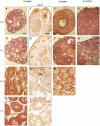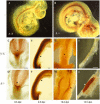Oct4 is required for primordial germ cell survival
- PMID: 15486564
- PMCID: PMC1299174
- DOI: 10.1038/sj.embor.7400279
Oct4 is required for primordial germ cell survival
Abstract
Previous studies have shown that Oct4 has an essential role in maintaining pluripotency of cells of the inner cell mass (ICM) and embryonic stem cells. However, Oct4 null homozygous embryos die around the time of implantation, thus precluding further analysis of gene function during development. We have used the conditional Cre/loxP gene targeting strategy to assess Oct4 function in primordial germ cells (PGCs). Loss of Oct4 function leads to apoptosis of PGCs rather than to differentiation into a trophectodermal lineage, as has been described for Oct4-deficient ICM cells. These new results suggest a previously unknown function of Oct4 in maintaining viability of mammalian germline.
Figures



Similar articles
-
Formation of pluripotent stem cells in the mammalian embryo depends on the POU transcription factor Oct4.Cell. 1998 Oct 30;95(3):379-91. doi: 10.1016/s0092-8674(00)81769-9. Cell. 1998. PMID: 9814708
-
Conditional knockdown of Nanog induces apoptotic cell death in mouse migrating primordial germ cells.Development. 2009 Dec;136(23):4011-20. doi: 10.1242/dev.041160. Development. 2009. PMID: 19906868
-
Analysis of Esg1 expression in pluripotent cells and the germline reveals similarities with Oct4 and Sox2 and differences between human pluripotent cell lines.Stem Cells. 2005 Nov-Dec;23(10):1436-42. doi: 10.1634/stemcells.2005-0146. Epub 2005 Sep 15. Stem Cells. 2005. PMID: 16166252
-
In or out stemness: comparing growth factor signalling in mouse embryonic stem cells and primordial germ cells.Curr Stem Cell Res Ther. 2009 May;4(2):87-97. doi: 10.2174/157488809788167391. Curr Stem Cell Res Ther. 2009. PMID: 19442193 Review.
-
In line with our ancestors: Oct-4 and the mammalian germ.Bioessays. 1998 Sep;20(9):722-32. doi: 10.1002/(SICI)1521-1878(199809)20:9<722::AID-BIES5>3.0.CO;2-I. Bioessays. 1998. PMID: 9819561 Review.
Cited by
-
Effects of a murine germ cell-specific knockout of Connexin 43 on Connexin expression in testis and fertility.Transgenic Res. 2013 Jun;22(3):631-41. doi: 10.1007/s11248-012-9668-1. Epub 2012 Nov 28. Transgenic Res. 2013. PMID: 23188169
-
Ectopic POU5F1 in the male germ lineage disrupts differentiation and spermatogenesis in mice.Reproduction. 2016 Oct;152(4):363-77. doi: 10.1530/REP-16-0140. Epub 2016 Aug 2. Reproduction. 2016. PMID: 27486267 Free PMC article.
-
Deciphering the stem cell machinery as a basis for understanding the molecular mechanism underlying reprogramming.Cell Mol Life Sci. 2009 Nov;66(21):3403-20. doi: 10.1007/s00018-009-0095-2. Epub 2009 Aug 7. Cell Mol Life Sci. 2009. PMID: 19662495 Free PMC article. Review.
-
Human short-latency auditory responses obtained by cross-correlation.Electroencephalogr Clin Neurophysiol. 1987 Jun;66(6):529-38. doi: 10.1016/0013-4694(87)90100-3. Electroencephalogr Clin Neurophysiol. 1987. PMID: 2438119 Free PMC article.
-
Global chromatin architecture reflects pluripotency and lineage commitment in the early mouse embryo.PLoS One. 2010 May 7;5(5):e10531. doi: 10.1371/journal.pone.0010531. PLoS One. 2010. PMID: 20479880 Free PMC article.
References
-
- Anderson R, Copeland TK, Schöler H, Heasman J, Wylie C (2000) The onset of germ cell migration in the mouse embryo. Mech Dev 91: 61–68 - PubMed
-
- Donovan PJ, de Miguel MP (2003) Turning germ cells into stem cells. Curr Opin Genet Dev 13: 463–471 - PubMed
-
- Ginsburg M, Snow MH, McLaren A (1990) Primordial germ cells in the mouse embryo during gastrulation. Development 110: 521–528 - PubMed
-
- Gomperts M, Garcia-Castro M, Wylie C, Heasman J (1994) Interactions between primordial germ cells play a role in their migration in mouse embryos. Development 120: 135–141 - PubMed
Publication types
MeSH terms
Substances
Grants and funding
LinkOut - more resources
Full Text Sources
Other Literature Sources
Molecular Biology Databases
Research Materials

